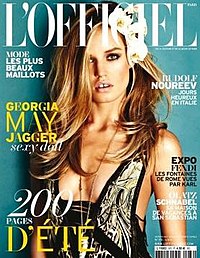L'Officiel
 June/July 2013 cover | |
| Categories | Fashion |
|---|---|
| Frequency | monthly |
| Total circulation (2006) | 101,719[1] |
| First issue | 1921 |
| Company | |
| Country | France |
| Language | French |
| Website | lofficiel |
L'Officiel (French pronunciation: [lɔfisjɛl]) is a French fashion magazine. It has been published in Paris since 1921 and targets upper-income, educated women aged from 25 to 49.[2] In 2006, it had a circulation of 101,719.[1] A men's edition of L'Officiel, L'Officiel Hommes,[1] and many foreign editions are also published.[2] The complete name of the magazine is "L'Officiel de la couture et de la mode de Paris".
History[]
L'Officiel was first published in 1921, the same year as Vogue.[1][3] It was the official publication of the Chambre Syndicale de la Couture Parisienne, a trade body representing all Paris couturiers,[4]:83 and took over the role of Les Elégances Parisiennes, a joint publication of a group of about twenty-five couturiers which became defunct in 1922.[5]:56 L'Officiel was a professional trade magazine, directed principally at international buyers of high fashion, both corporate and individual, and at those working in the fashion industry.[4]:83 The director was Max Bruhne, and the chief editor Yves-Georges Prade.[4]:83
Georges Jalou joined the magazine as artistic director in 1932.[1] Within a short time it had helped to start the careers of designers such as Pierre Balmain, Cristóbal Balenciaga, Christian Dior, and Yves St. Laurent, and came to be known as "the Bible of fashion and of high society".[1][6] Jalou became general director of the publication, and later bought it.[1] He transferred it to his three children in 1986: Laurent Jalou became the president of Editions Jalou, directed its editorial content, and Maxime Jalou was responsible for publication.[1] After the death of Laurent Jalou in 2003, his daughter Marie-José Susskind-Jalou became president of the company, and restructured the magazine's content to target a younger market than it did in its early years.[1]
The future of L'Officiel came into question during January 2021, as over 500 freelancers working for the magazine were left unpaid for a number of years, putting the stability of the finances and management under scrutiny in the press and in the French courts.[citation needed]
References[]
- ^ Jump up to: a b c d e f g h i Corine Moriou (September 1, 2006). "Le groupe édite L'Officiel, Jalouse, L'Optimum, etc.; Jalou, les magazines qui font des jaloux" (in French). L'Entreprise , page 54.
- ^ Jump up to: a b "Lifestyle Mag L'Officiel to be Published in Latvia from Sept". Baltic News Service, March 10, 2008. (Via LexisNexis.)
- ^ Agnes Rocamora (2009). Fashioning the City: Paris, Fashion and the Media. London: I.B. Tauris. ISBN 9780857731135, page 67.
- ^ Jump up to: a b c Véronique Pouillard (2014). Fashion for All? The Transatlantic Fashion Business and the Development of a Popular Press Culture During the Interwar Period. In: Sarah Newman, Matt Houlbrook (editors) (2014). The Press and Popular Culture in Interwar Europe. Abingdon, Oxfordshire; New York: Routledge. ISBN 9780415747639.
- ^ Mary Lynn Stewart (2008). Dressing Modern Frenchwomen: Marketing Haute Couture, 1919–1939. Baltimore: Johns Hopkins University Press. ISBN 9780801888038.
- ^ "la bible de la mode et des élégantes"
External links[]
- 1921 establishments in France
- Fashion magazines
- Magazines published in France
- French-language magazines
- Monthly magazines published in France
- Magazines established in 1921
- Magazines published in Paris
